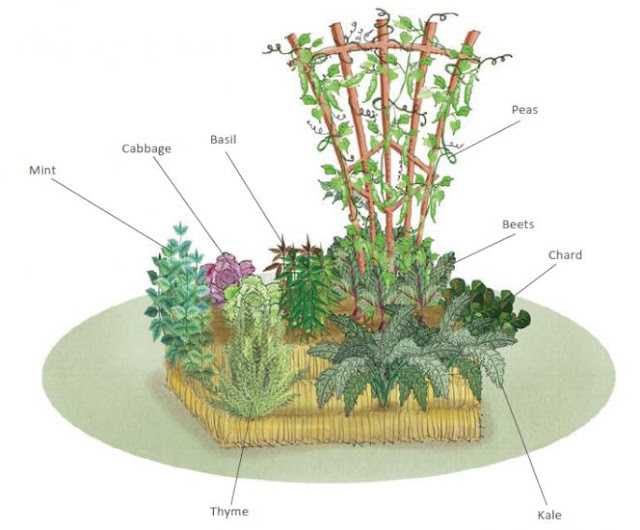Are you intrigued?
Let's give it a try!
What you need:
Straw bale
Small amount of potting soil
Organic fertilizer or compost
Starts or seeds
Pick a nice sunny spot:
Once the bales get wet, they will become much heavier and harder to move, so make sure it's where they're going to stay. (If you choose a grassy area, be sure to place several layers of newspaper or a piece of cardboard beneath to prevent grass and weeds from growing up into the bale.)
Position the bale:
Turn the bale with the narrow side up, so the strings holding the bale together are now on the sides (you don't want those strings to be on top in case you were to sever one while planting). On one narrow side, the straw will be folded over, and on the other side it will be cut. Make sure the cut side is up, as the hollow straws will allow moisture to penetrate better.
Condition the bale:
It is important to condition the bale before you plant. This process usually takes between 10 and 14 days. For the first three (3) days, simply water the bale thoroughly so that it remains damp. For the next six (6) days, in addition to watering it, use a liquid fertilizer to add nitrogen to speed up the decomposition. Simply add a capful to a gallon of water and pour it all on the bale. (Another option is to sprinkle a cupful of ammonium sulfate on the top of the bale on days 4-6 and then a half a cup days 7-9, each time watering the fertilizer in deeply.)
On day ten (10), return to simply watering the bale, and continue doing that until the temperature inside the bale starts to reflect the temperature outside. Use a compost or meat thermometer to keep tabs: you'll see the temperature start to rise after the first day or two, spike about mid-way through the process, then start to come back down. Once it reaches a consistent temperature that matches the temperature outside, the bale is ready to be planted.
Choose your plants:
You can grow just about anything in the bale that you can in the ground - with a few exceptions:
Tall plants like indeterminate tomatoes and corn, for example, get too tall and heavy, and can start to break the bale apart. (If you wish to grow tomatoes, stick to bush or other determinate varieties.)
Running plants like sweet potatoes can be harder to grow in a bale too.
We recommend smaller plants like herbs or flowers, or use it for your cooler weather leafy crops. Whichever plants you use, space them the same as you would in the ground.
Plant the bale:
Remove straw to form a hole that is as deep as the rootball of your plant. (Though if you are planting a tomato, you'll want to go deeper.) Place the plant in the hole, add some potting soil around it for extra nutrients and stability, then fill the rest of the hole in with some of the straw you removed and water deeply.
Water and fertilize regularly:
Your plants will receive less nutrition from the bale than it would from the soil, so it's important to fertilize them every week or two. You'll also want to make sure not to let the bale dry out.
And Voilá!
You can create your garden from as many straw bales as you'd like, arranged to fit
your need, aesthetic, or mood!
Happy Growing!
images, in order of appearance, from:
https://www.fix.com/blog/straw-bale-gardening/
http://blog.quartoknows.com/quartohomes/2015/03/13/one-straw-bale-at-a-time/
http://www.messagemedia.co/millelacs/outdoors/home_garden/end-reward-for-straw-bale-garden-black-gold/article_fc5bfa0a-daa6-11e3-b1cb-0017a43b2370.html
images, in order of appearance, from:
https://www.fix.com/blog/straw-bale-gardening/
http://blog.quartoknows.com/quartohomes/2015/03/13/one-straw-bale-at-a-time/
http://www.messagemedia.co/millelacs/outdoors/home_garden/end-reward-for-straw-bale-garden-black-gold/article_fc5bfa0a-daa6-11e3-b1cb-0017a43b2370.html


